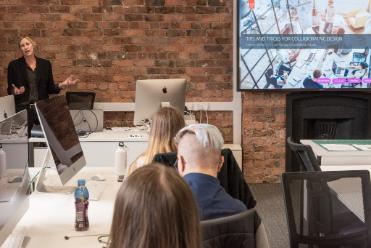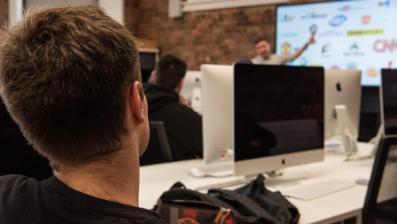This is how Liverpool Hope University is preparing students for a dynamic career in graphic designer.
Mark Wood is Senior Professional Tutor in Graphic Design at Hope, and has decades of industry experience under his belt, too.
And from developing income streams to carving out a niche as a freelancer, Hope’s designers are being schooled in real-world dynamism and resilience.
For Mark, a major element of a BA in Graphic Design at Hope is helping students to engage in real world professional practice.
He explains: “Professional practice lies at the heart of the graphics course at Hope and there’s opportunity to engage with industry throughout.
“We enable students to look for work placements, partnering closely with our careers centre, and making sure their input is embedded in our weekly sessions with students.
“Some of our students are working on paid freelancing positions, which means they can earn a little money while studying.
“But professional practice is more than just work placements - it’s about developing the skills that you’re going to need in industry.
“We might consider the ‘elevator pitch’, for example. If a graduate is at a networking event and someone asks them what they do, what are they going to say?
“Finding the right words is hard and needs rehearsing. They need to be fully equipped because it’s about selling yourself and your ideas.”

Mark, a former mentor trainer with tech giants Apple, says it’s crucial students are also prepared for the often under-discussed elements of graphic design work.
He adds: “We contextualise things like running cost analysis - how much is a project going to cost a client?
“If you’re going to be self-employed, what do you need to earn to achieve the living you want? What happens if you receive a design brief from abroad in the middle of the night as part of the global economy?
“This ethos provides a motivation for students, props them up and makes them self-reliant, rather than being too protective. No one benefits from being wrapped up in cotton wooll.
“We help them to understand what really comes next and we prepare them for the pace of work as a graphic designer.
“And resilience is key, something we work with students to develop. If things go wrong, and it may not be your fault, how do you cope?
“Most of all, it’s about encouraging students to think about graphics in the broadest sense of what a portfolio career really is.”
You might have an idea in your head about what a graphic designer might do.
Mark himself has worked in diverse fields such as photography, designing page layouts, creating logos, making interactive books, websites, videos, and posters.
But he wants students to realise that ‘graphics’ is much more diverse than people realise… and it’s everywhere you look.
He reveals: “With some degree courses, students want a learning experience. With graphics, it’s a job description.
“We talk to students about the diversity of income streams. A lot of people would like to be able to create merchandise, like T-shirts. But what kind of freelancing income will that realistically bring you?
“A lot of graphic designers also want to create album covers. I’ve done it myself and it’s great to see your work in record stores.
“It’s not the bread and butter work of a graphic designer, however. It’s just one aspect .
“For me, graphics is about solving communication problems and demonstrating visual literacy.
“And we look at the breadth of work available to give students a look at what’s happening in industry right now, and where they might gain employment.”

An eye-catching recent example of what graphics can be is the Government’s recent Coronavirus logo switch, where the black and red ‘Stay at Home’ banner switched to a green and yellow ‘Stay Alert’ message.
He explains: “That’s graphics, and really important, but perhaps not ‘graphics’ as people know it.
“Likewise every sign you see is a form of graphics. How do you find your way around the University? How do you drive around the country? What do you see when you look at apps?
“You’re taking in signs and directions constantly and these are visual languages. And so we look at user interface and user experience design as part of the course.
“In Higher Education, Hope is ahead of the curve in that regard.”
There’s another reason to study graphics at Hope - you’ll also get the chance to take part in workshops run by software heavyweights Adobe, thanks to a unique professional partnership.
Mark, who’s also a member of the Adobe Education Exchange programme - a network of educators around the world working in schools and Higher Education, who share resources and expertise on industry trends - says: “Adobe recently delivered an industry-focused look at what’s happening, and what will be happening, in industry.
“Adobe talk about ‘content velocity’ - this idea that you don’t just design one graphic for a product, you design for multiple versions of a product in multiple regions of the world. You have to be able to scale up and distribute that work in multiple languages and on multiple platforms, on all kinds of devices.
“If you don’t understand the technology, you’ll never get the velocity required to get the content pushed out.
“Students get a lot out of these discussions. We want to challenge students to raise their aspirations as much as possible.”
As for what Mark is looking for in potential applicants, he adds: “We’re looking for problem solvers, and those with an enquiring mind.
“You need to have an interest in a breadth of visual communication, which goes beyond fine art, or the obvious graphics.
“It’s about having an understanding of how words and pictures communicate, and having a willingness to deconstruct and question how that communication happens.
“A degree in graphics isn’t just about learning how to use software, either. Yes, it’s essential - but only to the point where we can help skill people up.
“You want to get to the point where the software, in effect, disappears.
“A writer might like to use a favourite pen, but the pen does not form the words. The difficult bit is the creative challenge, what you’re going to write, or draw, how you analyse that, and what it says.
“Sometimes it’s also about being funny and witty, as well as serious. This is the design thinking at the heart of Graphic Design.”
To find out more about studying for a BA in Graphic Design at Hope, head here:



